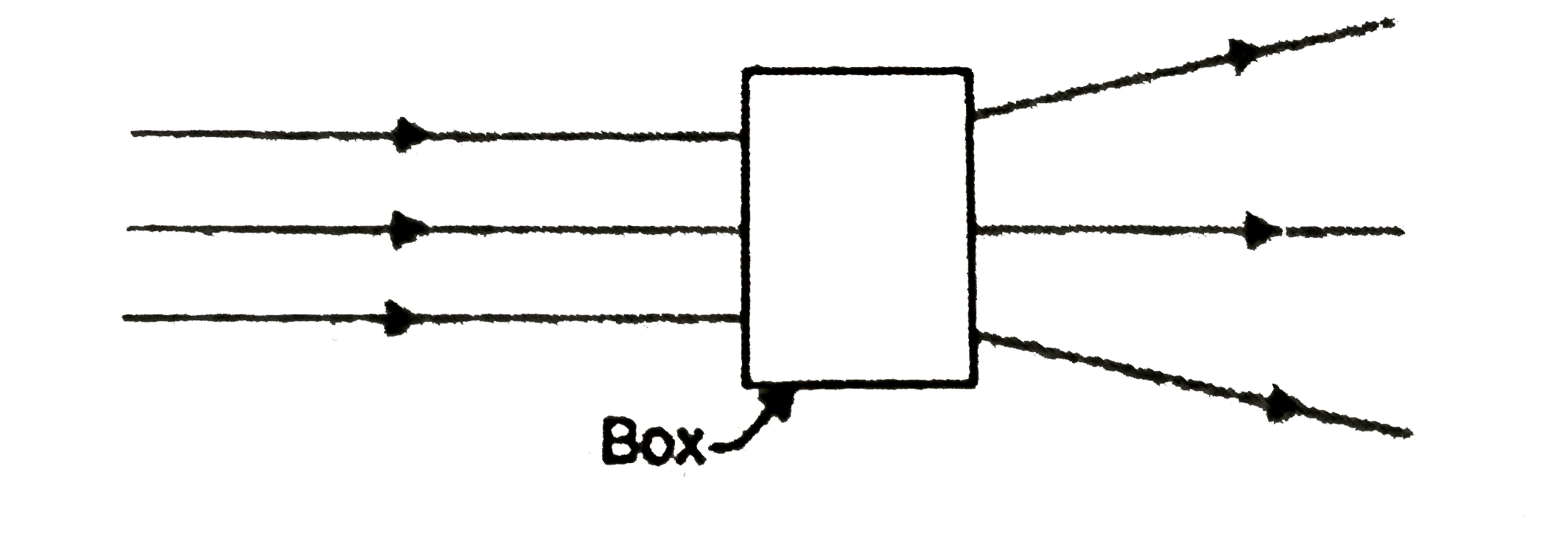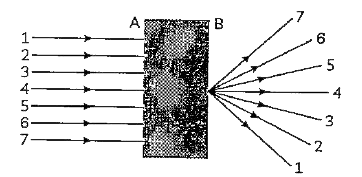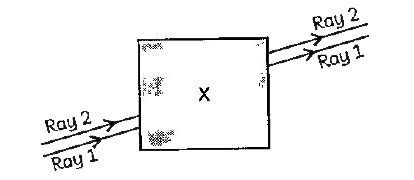A beam of parallel light rays is incident through the holes on one side of a box and emerges out through the holes on its opposite side as shown in the diagram below:

Which of the following could be inside the box?
a rectangular glass block
a concave lens
a convex lens
a glass prism
The correct Answer is:C
c
Topper's Solved these Questions
- REFRACTION OF LIGHTBOOK - LAKHMIR SINGH & MANJIT KAURCHAPTER - REFRACTION OF LIGHTEXERCISE - LONG ANSWER TYPE QUESTIONS
3 Videos
- REFRACTION OF LIGHTBOOK - LAKHMIR SINGH & MANJIT KAURCHAPTER - REFRACTION OF LIGHTEXERCISE - SHORT ANSWER TYPE QUESTIONS
1 Videos
- REFRACTION OF LIGHTBOOK - LAKHMIR SINGH & MANJIT KAURCHAPTER - REFRACTION OF LIGHTEXERCISE - VERY SHORT ANSWER TYPE QUESTIONS
1 Videos
- REFLECTION OF LIGHT BOOK - LAKHMIR SINGH & MANJIT KAURCHAPTER - REFLECTION OF LIGHT EXERCISE - Very Short Answer Type Questions
1 Videos
- SOURCES OF ENERGY BOOK - LAKHMIR SINGH & MANJIT KAURCHAPTER - SOURCES OF ENERGY EXERCISE - NCERT
8 Videos
Similar Questions
A beam of light is incident through the holes on one side of a box emerges out throught holes on its opposite side as shown in the following figure:

The box contains:
View SolutionNoor, a young student, was trying to demonstrate some properties of light in her Science project work. She kept ‘X’ inside the box (as shown in the figure) and with the help of a laser pointer made light rays pass through the holes on one side of the box. She had a small butter-paper screen to see the spots of light being cast as they emerged.

What could be the ‘X’ that she placed inside the box to make the rays behave as shown?
View Solution
Knowledge Check
A beam of light is incident through the holes on side A and emerges out of the holes on the other face of the box as shown in Figure. Which of the following could be inside the box ?
 Aconcave lensBRectangular glass slabCPrismDConvex lens
Aconcave lensBRectangular glass slabCPrismDConvex lensBeams of light are incident through the holes A and B and emerge out of box through the holes C and D respectively as shown in Figure. Which of the following could be inside the box ?
 AA rectangular glass slabBA convex lensCA concave lensDA prism
AA rectangular glass slabBA convex lensCA concave lensDA prismLenses made of transparent materials such as glass or plastic with curved surfaces. Diverging lenses are thicker at their edges than at their centres and make light rays passing through them spread out. Converging lenses are thicker in middle than at edges and make light rays passing through them focus at a point.
A beam of light is incident on the box through the holes on side A and emerges out of the holes on the side B of the box:

Which of the following is present the boxAConcave lensBRectangular glass plateCprismDConvex lens
Noor, a young student, was trying to demonstrate some properties of light in her Science project work. She kept ‘X’ inside the box (as shown in the figure) and with the help of a laser pointer made light rays pass through the holes on one side of the box. She had a small butter-paper screen to see the spots of light being cast as they emerged.

If the object inside the box was made of a material with a refractive index less than 1.5 then the
View SolutionCase : Noor, a young student, was trying to demonstrate some properties of light in her Science project work. She kept 'X' inside the box (as shown in the figure) and with the help of a laser pointer made light rays pass through the holes on one side of the box. She had a small butter-paper screen to see the spots of light being cast as they emerged.

What could be the 'X' that she placed inside the box to make the rays behave as shown?
View SolutionCase : Noor, a young student, was trying to demonstrate some properties of light in her Science project work. She kept 'X' inside the box (as shown in the figure) and with the help of a laser pointer made light rays pass through the holes on one side of the box. She had a small butter-paper screen to see the spots of light being cast as they emerged.

If the object inside the box was made of a material with a refractive index less than 1.5 then the :
View SolutionA light ray is incident at an angle 45∘ on parallel sided glass slab and emerges out grazing the vertical surface. The refractive index of the slab is
View SolutionCase : Noor, a young student, was trying to demonstrate some properties of light in her Science project work. She kept 'X' inside the box (as shown in the figure) and with the help of a laser pointer made light rays pass through the holes on one side of the box. She had a small butter-paper screen to see the spots of light being cast as they emerged.

Her friend noted the following observations from this demonstration:
(I) Glass is optically rarer than air.
(II) Air and glass allow light to pass through them with the same velocity.
(III) Air is optically rarer than glass.
(IV) Speed of light through a denser medium is faster than that of a rarer medium.
(V) The ratio: sin of angle of incidence in the first medium to the ratio of sin of angle of refraction in the second medium, gives the refractive index of the second material with respect to the first one.
Which one of the combination of the above statements given below is correct.
View Solution
